Jeanette Winterson, E. L. Doctorow, Jessica Francis Kane, Sheila Heti
Which author do you pick. Hmm!
Austin Has Changed A Lot Since My Last High-Profile Appearance Here In 2012
by Awl Staff
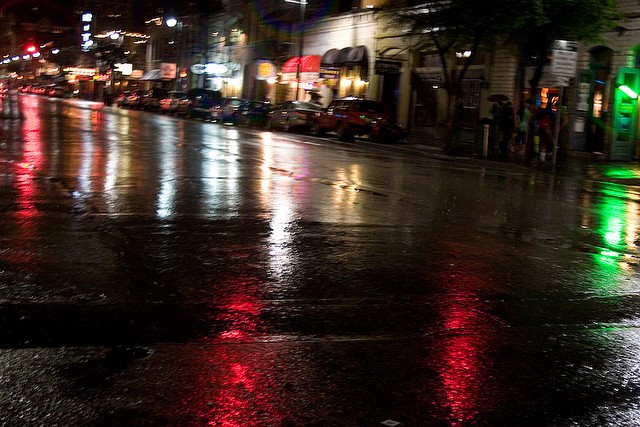
It’s awesome to be back in Austin, again. And while this certainly isn’t my first appearance on a popular #SxSW panel, things do feel different this time.
When I was first invited to Austin to speak at South+Southwest, I didn’t even have an iPhone. And that’s not to question my role as an Early Adopter, it is just to point out that the iPhone had yet to go on the market. It was quite a long time ago! (But not so long ago that I’ve noticeably aged in either my interests or appearance.) Why, we didn’t even have Yelp! back then. As a common joke among SxSW insiders goes, “I’ve been coming to Austin so long that I was here before the first time The Strokes broke up because nobody bought their new record.” If any of you from The Strokes are reading this, as you might be, just know that it’s all in fun.
That’s what SxSW is all about, to me: fun. But it’s not the kind of fun so many South by SW “n00bs” seek out. It is the kind of fun that comes from working hard and networking harder. Of course there are parties and hotel sex and goodie bags and secret concerts — those of us blessed enough to attend still remember the exclusive delight of 2006’s Flaming Lips set — but all of that serves a higher purpose: the advancement of our careers and the technology or media we market at these events.
Few can forget the appearance of Twitter in 2007. And for the length of that year’s SX-S.W., at least, we finally had our own personal network of connections all but unknown to those who were unable to “get to Austin” that year.
Today, South-Southwest is the biggest media-film-technology conference around, and one of the few with so many musical acts to perform for the attendees.
Austin, too, has grown up. Once the kind of backwater you would avoid if you knew better, the little town has become a city in its own right. A service sector known mostly for casual-dining chains and unhygienic BBQ joints is finally ready to deliver quality food and drink to the New Yorkers and Californians who bring so much to this sleepy Texan cowtown. Just since last year, I have noticed a real upswing on Yelp! in the Asian Fusion and vegan brunch categories. It is not exaggerating to say that back in 2006, when all of this started, there were perhaps two decent restaurants in Austin — and here I mean, obviously, “decent for the South.”
In a very real sense, however, Austin is becoming more than just a Southern town with its legacy of slavery and ignorance. Through the kind of media-is-the-message synchronicity we’ve long championed at SouthxSouthWest, it’s as if the “West” part of the festival’s name has become a kind of reality. Just last night, after the Depeche Mode showcase with a very phat guest spot by “Fiddy,” I found myself with a beautiful girl who had nearly the same badges as I wore. We slipped into a bar that could have been right out of a Western cowboy video game, and I joined the crowd by ordering a local favorite, the Pabst Blue Ribbon regional beer in its own can.
“This is a new thing,” I said to her. She looked up from a text and said, “Sometimes I think Austin is just a theme park made for people like you.”
“Like us, you mean.”
Well, I do not want this to turn into an episode of the hip show “HBO Girls,” so I will leave off this “twit-patch” (meaning, a dispatch from someone who has been on Twitter a long time) with the one thing we are all thinking but feel bad about saying:
WHAT IS UP WITH THE STUPID RAIN??
I’m sorry, rain? We do not spend six grand to fly to the middle of nowhere and then have rain.
It’s impossible to find a taxi, and of course they don’t even have subways here. Sorry I forgot my SUV with the cow horns on the hood, but I did come here on an airplane, maybe you’ve heard of them in Willie Nelson songs or whatever.
Sou-SouWest is still pretty killer and the restaurants and service people have really stepped up since I began coming here, but the rain is bullshit.
Photo by pimginc.
New York City, March 7, 2013

[No stars] A peek out the window found snowless ground, an illusion of reprieve quickly dispelled by airborne flakes floating past. The snow thickened for a while, but that was an illusion too: the first in a string of damp squibs trying to pass for firecrackers. Now the snow swirled; now it blew sideways; now the vectors turned vertical as rain mixed in; now… where was it? It was bright and snowing again, then dark and snowless. Everything but a committed, proper snowstorm. By evening, with thick flakes aloft again on the wind by the river, it couldn’t even sustain conversation at a cocktail party.
Here Is How To Go Out And Enjoy Art Like A Rich Person

This weekend is The Armory Art Fair in New York City. It is not currently held in one of New York City’s fine dilapidated armories — these days, we’ve used some of those to house the large numbers of people made homeless by Hurricane Sandy! Oh and also the one on Park Avenue serves in part as a shelter for mentally ill women, did you know?! — but over on piers 92 and 94, which is basically where West 53rd Street runs into the Hudson. Yes, brr.
In this art fair, a couple of hundred galleries have wedged wares into little booths. People walk around and look at these things. And run into friends. And sometimes buy things. Like much of New York City in general and the art world in specific, the Armory is intended for rich people. (Here’s the photographic proof.) It’s one of the niche worlds of the City — like the dance scene, or the opera scene, or I guess the artisanal butchery scene — that you can tunnel deeper and deeper inside, as far as you want, or not. The further you enter the cave, the more cognizant you become of the jokes, the interplay, the scandals, the status-jockeying. And the prices, I guess. Same thing?
But you don’t need any of that! That’s for later, if you want. The awesome thing about art fairs — and about galleries — is that, on any given day, you have this tiny window during which you can see amazing things. You will never ever be able to see almost all this art again. Isn’t that cool? Don’t you think that’s fascinating? DO YOU LIKE THINGS???
The typical life cycle of a piece of art is that it is made and then never seen anywhere. (Art is like books in this regard! Books are written and barely even ever printed out, on average!) A ridiculously small percentage of art is then shown in a commercial or noncommercial gallery. Much of that then goes unwanted. But a small percentage of what is shown is sold, and it goes into someone’s home, or even more rarely, an institution. And maybe some will be brought out or toured or loaned in the future, or eventually sent to auction, and so made visible again. But most, for much of the time, is just above someone’s couch. (Or more likely, in racks in their cellar.)
And so you can see why the emphasis in art is so relentlessly commercial. That money being exchanged for art is so rare creates an undue emphasis on it. And also people like money, and the getting of it.
One downside of this is that the art that is privileged is the art that will make everyone money. And so it is often trendy, or trendily decorative, or ridiculous. But that’s the point of looking at a lot of art. You can learn to see things you enjoy, and look beyond the stupid things that are designed to trick rich people out of their money.
Because in this process, capitalism has given you a wonderful gift! That gift is that these big fancy shops that sell art and these art shows that display art for such a short time are available to you. You, whether you are an impoverished rube or a painter or a semi-rich person, are allowed to walk around and examine things. It’s kind of great!
Here are some things to try this out at, right now!
• The Armory Show itself is up. Here is its
• Here is a pretty great list of all the alternative short-term art stuff going on around town right now, mostly fairs. Highly recommended: “Spring/Break,” which is happening in NoLIta, and the Independent fair.
• This Saturday night, the Bushwick galleries are staying open till 10 p.m., and here is a map.
• And here, for after the fairs are over, is a Chelsea gallery map.
How do you go out and see art, you ask? Well, put on some clothes, appropriate for the weather. Then go forth. Comfortable shoes are wise. Commence a logical wandering. Don’t touch things you shouldn’t touch. Smile at the people who work in the galleries or fair booths. Keep your dumb questions and fake questions that are actually statements to yourself, unless you’re one of those people who’s never ashamed of asking dumb questions. A gallery will have a nice thing on a desk somewhere that explains more about what you’re looking at, if you care. And they might have a price list out. But if they don’t, and you want to know how much something is, you can just ask a person at a desk for the price list. (“Hello, may I see the price list?”) The laws of New York State require standardized pricing, because of the history of setting different prices for different sorts of people, so now everyone is supposed to have a list. Sidebar: maybe don’t do this at galleries where things are obviously $3 million.
Through this process, you will learn about what excites you and why.
If you want to buy something, that’s a little more complicated. We can talk about that later! But honestly it’s a lot like buying shoes, except in most cases everyone has already bought all the shoes you want and there’s a waiting list of several years for new shoes that you might like as well, though you might not, and in the meantime, you have to buy these OTHER shoes, shoes that are ugly that no one wants, to keep your place in line to get the shoes you want. But in other respects it is almost exactly same, except worse. But like, there is sales tax.
So spring is right around the corner, and what is more romantic than exploring odd corners of the city in springtime? (Drinking milkshakes with two straws, that’s what, but that’s more of a summer thing.)
Cannibals And Cat Women: How A Creepy Classic Radio Program Came To Be
Cannibals And Cat Women: How A Creepy Classic Radio Program Came To Be
by Chris Morgan
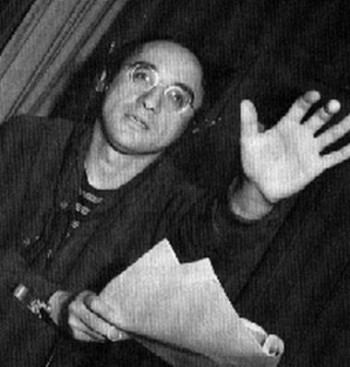
Delivering scares, according to Wyllis Cooper, was a matter of “raiding the larder.” His radio program “Lights Out,” which premiered in 1934 on NBC station WENR in Chicago, aired at midnight, specializing in tales of the horror and supernatural. Food, pots and cutlery provided sound effects for a wide range of disturbing acts from Cooper’s scripts, including breaking bones (cracking spare ribs), burning flesh (frying bacon), severed appendages (chopping carrots and cabbages), being murdered (stabbing raw pork), cannibalism (eating spaghetti), and so on. Cooper, a former advertising copywriter and continuity editor for CBS and NBC, ran the show for two years, exiting for a career in Hollywood (to write such films as Son Of Frankenstein). The show was handed over to Arch Oboler, another Chicago writer with credits to mainstream shows like “Grand Hotel.” In “Lights Out” the 26 year old saw a chance to push his own artistic ambitions. Where Cooper’s scripts were punctuated with gross-out sound effects and bits of mordant, pulpy humor, Oboler sought to create terror through the gradual ratcheting up of atmosphere and psychological tension. His debut episode, “Burial Services,” told the tale of a paralyzed girl being buried alive. As John Dunning recounts in On The Air, the backlash was immediate, and NBC was inundated with more than 50,000 letters of complaint.
While not his creation, “Lights Out” today is mostly associated with Oboler, and for good reason. (Oboler himself, though, would continue to credit Cooper for the originality of what he’d created with the show for decades after.) As Cooper had, Oboler wrote and directed most of the episodes. Early drafts were written as Oboler lay in bed, speaking lines and acting out scenes into a Dictaphone as they occurred to him, a cigarette going in one hand. This method allowed him to produce scripts at a prolific rate, and it also gave the stories an odd, fluid, experimental quality. The “Lights Out” episodes written by Oboler could play more like tone poems than narratives, sometimes being told from the stream-of-consciousness inner-monologue of a single character, such as this one from “Kill.”
I closed my eyes. I slept. And then… it happened. The strange murmuring in my head. Yes, that’s how it started. The murmuring as if in warning. And then in the darkness around me, strange faces lifting and falling… white faces, faces without hope. Their eyes full of horror, their white, bloodless lips pleading wordlessly in a way that made the heart in me cry out in pity!
The best episodes of “Lights Out” were devoid of any moral sense; it was a show low on heroes, hope, or resolution. Here are the plots to a few classic Oboler episodes: The narrator who we hear in “Kill” is driven to murder by the voice of a demonic woman intoning “kill … kill … kill” over and over in his head. (He dies of a heart attack just as his guilty verdict is handed down.) In “The Flame,” a fire obsessive goes full-pyromaniac when he inadvertently conjures a “spirit of the flame,” burning down multiple buildings with scores of people inside, children included. Oboler delved into metafiction as well, going so far as to insert himself at the center of the blackly humorous episode The Author And The Thing. In the story a fatigued Oboler — he played himself in the broadcast — struggles to write his next play (“a press agent named Black killing a man named White” is one abortive plot), only to create a real life “concentration of all the evil in men’s hearts and minds. A tremendous force of fiendishness and inhumanity…” after reading an incantation aloud.
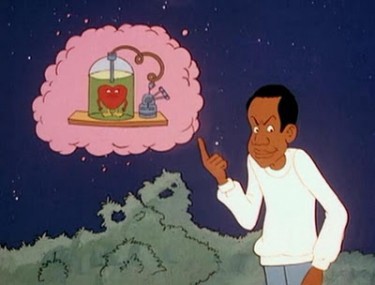
Oboler’s imagination could take episodes into outlandish directions, but his production methods ensured that even the most insane-sounding premises came off. “The Dark” tells of an ambulance crew that encounters a black fog that turns flesh inside out. The sound of the flesh was produced with a rubber glove and a straw basket, but listeners without the privilege of knowing that could only squirm at that simple, effective combination. Chicken Heart, from title to concept, seems even more ridiculous on its face — and indeed, it is literally about a chicken heart that grows ceaselessly, engulfing a city, the United States, North America, and engulfing its protagonist (the scientist who had unwittingly unleashed the horror) before it seemingly spreads across the world. As the episode builds, the rhythmic thumping of the heart grows in intensity as a kind of doom signal. It was enough to stick in the minds of both Bill Cosby, who recalled it both in his standup act and paid tribute to it in an episode of “Fat Albert,” and Stephen King. In Danse Macabre King observes: “Oboler, like so many in the horror field — Alfred Hitchcock is another prime example — are extremely alert to the humor implicit in horror, and the alertness was never better than in the Chicken Heart story, which made you giggle at its very absurdity even as the gooseflesh raced up and down your arms.” The Chicken Heart was not the only odd, outsized terror to be featured in an Oboler stories: “Revolt of the Worms” was about giant worms, and “Cat Wife” was about a man (played by Boris Karloff) whose wife had morphed into a human-sized cat.
“Lights Out” developed a loyal following and when incarnations of it ended, it was usually from lacking a creator rather than an audience. The early run of the show lasted until 1939, a year after Oboler departed to write more mainstream “message” plays about the rise of fascism and other issues that preoccupied him. From 1942 to 1947, however, the show would come and go. Oboler himself resurrected it for a year in 1942, now for CBS. To free up his time for other projects, Oboler reused older episodes, a short-term convenience that became a long-term blessing as the 1942–43 broadcasts are the only ones widely available today.
The show still has its loyal fans, but it’s mostly understood today in the shadow of “The Twilight Zone.” It’s true that Arch Oboler was one of Rod Serling’s chief influences, one who shared with him an urge to moralize in his stories. But “The Twilight Zone” is almost entirely dominated by moralizing, with most of its memorable episodes being wrapped in the framework of having to deliver a pressing message (think here of the critiques of the Cold War in “The Shelter” and “The Monsters are Due on Maple Street” or of conformity in “The Eye of the Beholder”). Strangely, given the two shows’ relative fames today, many “Twilight Zone” episodes haven’t aged as well as those of “Lights Out.” Though the show’s production values seem quaint today, its sense of mood hasn’t been so easily equaled. The debt that shows like “The X-Files” and “Millennium,” wherein the unexplained often remains that way, owe to “Lights Out” is greater than the debt “The Twilight Zone” owes to “Lights Out.”
Oboler would leave radio for a less-than-memorable career in film, albeit one that includes work on the first 3D color film, Bwana Devil. But he returned to recording in 1962 with a stereo record that proved to be a perfect swan song for “Lights Out.”
Drop Dead! An Exercise In Horror!, a 36-minute-long album, contains unsettling vignettes in the “Lights Out” style, some of which (“The Dark,” “Chicken Heart”) are abridged versions of old :Lights Out” episodes. The longest track is over eight minutes and the shortest is over a minute and a half, and this included introductions from Oboler himself. There is, at first look, an appearance of mercenary self-cannibalizing to the project, but overall it’s an effective mood record. Listened to today, the atmosphere-heavy but context-light narratives call up associations to (1) witnessed crimes, (2) last year’s found-footage omnibus V/H/S, and (3) noise rock records. Going off on his Dictaphone improvisations, Oboler’s sketches could become dissonant, disorienting, emotionally agitated and absurd. Like the best guitar droning, these plays sink into the listener’s mind rather than confront or scare them outright.
That was the “Lights Out” way, though — scare people, sure: startle them with sound effects, thrill them with ludicrous, spooky plots — but lead the listeners along in such a way that they themselves will supply what’s truly frightening out of their own imaginations.
Related: The Man Behind The Brilliant Media Hoax Of “I, Libertine”
Chris R. Morgan is the editor of Biopsy magazine.
Would You Like To Curate 17,000 Star Wars Characters?

“Lucas had already done the cataloging. His company maintained a database called the Holocron, named after a crystal cube powered by the Force. The real-world Holocron lists 17,000 characters in the Star Wars universe inhabiting several thousand planets over a span of more than 20,000 years. It was quite a bit for Disney to process. So Lucas also provided the company with a guide, Pablo Hidalgo. A founding member of the Star Wars Fan Boy Association, Hidalgo is now a ‘brand communication manager’ at Lucasfilm. ‘The Holocron can be a little overwhelming,’ says Hidalgo, who obsesses over canonical matters such as the correct spelling of Wookiee and the definitive list of individuals who met with Yoda while he was hiding in the swamps of Dagobah.”
— Whether this sounds like the best or worst job in the world says a lot about the particular way you wasted your youth. Much more about the Disney-Lucasfilm deal is revealed in this Bloomberg Businessweek piece.
Photo by Simon Q.
My Attempt To Make Elderflower Cordial
My Attempt To Make Elderflower Cordial

A series about foods we miss and our quests to recreate them.
A few years ago, on a trip to Edinburgh, I had an elderflower drink that I keep thinking about. I don’t remember what it was specifically called on the menu — cordial, elderflower water, or some variant — just that it was so cool and refreshing that it seemed weirdly magical on that day. It was a late afternoon in November. My husband and I had been to this little graveyard in the old part of the city (martyrs, moss) and then stopped into a restaurant nearby. It was too early to be having dinner but that’s the nice part of being a tourist; it feels like being a ghost, you drop in when you want to and leave when you want to and no one speaks to you much. I mention this background because all of it — the greyness, the chill of standing outside reading plaques, the emptiness of the restaurant — are mixed up in my mind with how the cordial tasted. It came in a carafe with ice; it was clear; it was quenching like water, but slightly sweet and scented. I drank it all and would have ordered another but I’d done the exchange rate and it was ten dollars.
When I got home, I had some sort of enterprising Liz Lemon-y plan of mixing up a giant batch of cordial and giving bottles of it to friends for the holidays. Like these but homemade: “Here, taste happiness.” I got as far as bookmarking a recipe. (I hope everyone enjoyed the expired-but-still-completely-redeemable Bed Bath & Beyond coupons they got instead.) But after a winter of drizzling St. Germain into everything that passed by — wine, orange juice, coffee — it seemed like time to return to a nonalcoholic version of an elderflower drink. It’s very easy to make cordial, but I was curious whether it would turn out to have the same properties of the Edinburgh one — or instead taste like some sweet, agreeable, but largely generic soda.
There are many, many recipes for elderflower cordial online, mostly on British cooking sites, some made with dried elderflowers, others with fresh ones (recipes for the latter frequently include the instruction to be sure to shake off any insects from your flowers before you start). I used dried elderflowers, with this recipe as a guide (by the bye, if you want to booze up your cordial, that recipe advises adding in a couple shots of vodka and a squeeze of lime juice).
This makes a pretty small batch! But that seemed fine as an experiment.
Ingredients
• two lemons
• sugar
• 2 cups water
• 2 tsp. citric acid (they sell this at my local grocery store, but it seems like an ingredient you might potentially have to scout ahead)
• dried elderflowers (I ordered mine online, and used the entire 2 oz. package)
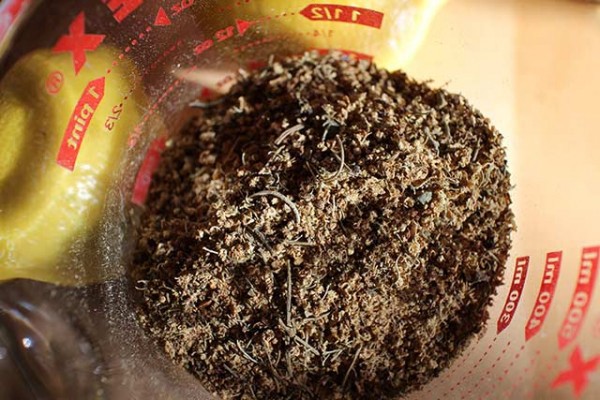
The elderflower package when opened smelled like… dust? Henna? Not like perfume.
The process itself is pretty easy. Boil the water and then add in the sugar (standard sugar water). Let this cool. Zest the lemons, slice them, throw them in a bowl with the dried elderflowers and a spoonful or so of citric acid (the original recipe called for the equivalent of 3 tsp., if I did the conversion right, but that seemed like too much when added, like Woody Allen had just sneezed a bunch of cocaine into the bowl, so I scooped some back out). Once the sugar water has cooled, pour it into the bowl. (With the addition of the sugar water the mixture smelled even more like henna, with the cut of the lemons drifting in.) Saran wrap the bowl and stick it in the fridge for two to three days to steep (I did three).

Strain. If you make these proportions there won’t be much, but the cordial gets diluted with water (you can use regular, sparkling, tonic, whatever).

Strained and poured into a jar, the cordial was a disappointing dark ginger-ale color. (I once had a mechanic hold up a valve with liquid inside it that was the exact same shade.) It was obviously, even from appearance, going to be different from the one I’d had, which was clear (at least in memory) and maybe proprietary, too, as other recipes I’ve seen online all had some citrus-y color to the finished products. (The elderflower cordial-knowledgeable out there may be able to explain.) It improved in looks once diluted — I landed at a rough 1:3 blend. It did not, at least, taste like henna. It was sweet, fizzy — not surprisingly, very much like drinking St. Germain… with ice cubes. More sunny than the drink I remembered. All in all: Perfectly pleasant, would do business again (most likely in summer), but not something I would bottle up and offer a friend as some lost Narnia White Witch drink.
Previously in series: My Ambitious Attempt To Make Puerto Rican Pasteles
Man Apologizing All Over Town
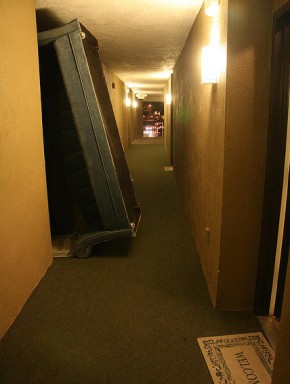
“Dear Residents of 208 East 7th Street: Sorry for leaving that couch outside our door on the fourth-floor stairwell for two weeks.
We were just moving in to the building, my friend Tim and I, fall of 1995. I graduated from college that spring, and this was the first apartment I ever officially leased. And I didn’t know a lot about neighborly etiquette. Or making a good first impression.
The couch did not completely block the stairwell, or access to the hallway off which our door opened. It was off to the side, tipped up on an armrest, leaning vertically against the wall. Obviously we would have preferred it to be inside our apartment.”
— Guess who, guess where. Did we mention you should buy this book, and then buy another one to give as a gift? Because you so should.
Photo by youngthousands.
A Poem By Douglas A. Martin
by Mark Bibbins, Editor
D. L.
green bulb green eye green
red light hangs in the neighbor’s window
green issue shakes out green rugging
vie lets I could verge you
vices I could kiss
yellow honey of the knot
yellow tail not the rumble
blue clear linden in your blue in fired
blue car our first car
blue fullness of fired pointed blue raving
orange flowers in the grove
orange sun do I dare
red paper tonguing the sun
red and full and then material
red bird endlessly flying
red bell heads
Douglas A. Martin’s books include Once You Go Back (Seven Stories, 2009), Your Body Figured (Nightboat, 2008), and In the Time of Assignments: poems (Soft Skull, 2008).
My God, it’s full of poems! You may contact the editor at poems@theawl.com.
Woman Waits One Sentence Before Mentioning Her TED Talk
“’Sitting has become the smoking of our generation.’ I argued this in my recent talk at TED2013”
